Pulse under control? How and why to measure the pulse on the move
 Bashny.Net
Bashny.Net
Now the market has appeared a lot of variety of portable gadgets to measure heart rate. To understand what is a fundamental difference between them, and for what purposes will approach one device, but for some - more, it is not quite trivial task.
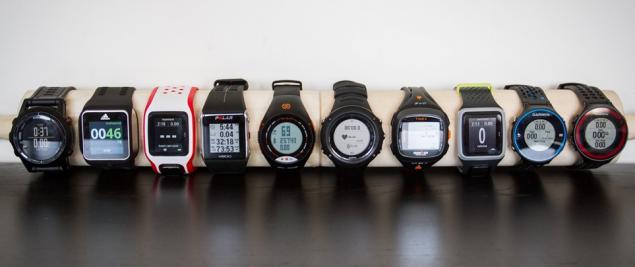
We will try to describe the main technical features that define the functionality of the heart rate monitor to an untrained user is not overpaid for a device with redundant functionality, or hoping a simple device to solve the problem that it can not afford.
So, in spite of the wide variety of manufacturers and models, virtually all devices for measuring heart rate can be divided by a pair of main features:
- Pulse technology used;
- The protocol to use wireless data transmission;
The determining factor in terms of precision, quality, convenience Pulse - of course used for this technology.
In fact, the only review of technologies for measuring heart rate in runet, found only on geektimes ( time and два ), which is not surprising, but becomes the rule. Not all of the possible techniques may be used for the described mobile contact, so consider only two:
Electrocardiography - registration changes of electric fields that arise in the heart, to identify potential differences is necessary to measure at least two points of the body, possibly far apart
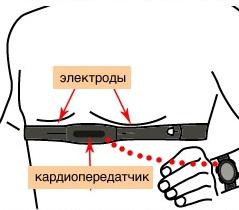
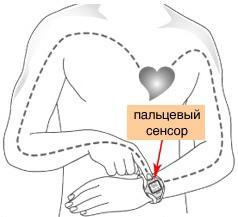
The figures are two types of such devices, despite differences in appearance, measurement technology, and accordingly accuracy - close.
Plethysmography - the measurement of the pulse based on the registration of the change of volume in the body, filled with blood (as a rule - in the blood vessels). Measuring occurring with a pulse wave by using mechanical, optical or impedance (electrode) methods. Mobile gadgets used almost exclusively optical plethysmography - photoplethysmography.
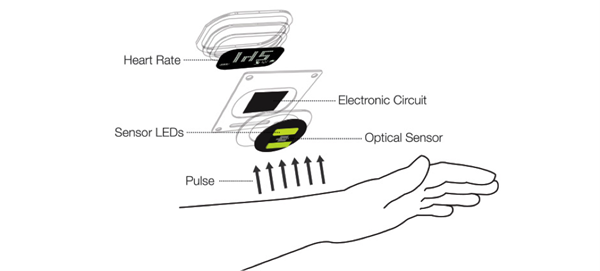
The table below briefly summarizes the main characteristics for each of the pulse measurement technology:
Option th> Electro-cardio (measurement at two points) th> Photo-plethysmography th> Benefits High accuracy Ease of use Weaknesses The disadvantage of the use / need to replace the belt with pins ( It depends on the manufacturer and usage in a month ... year) Low accuracy / dependence of measurement accuracy, the quality of the sensor, the weather (direct sunlight knock readings), the moisture content tr > Scope Sport Professional / Amateur Sports Amateur Sport / Sport «for fun» / Constant control pulse
To the reported heart rate is not remained in the pulse sensor and can be displayed in real time to the user, it is necessary to provide wireless transmission of data from the sensor to the display device or devices from the combined clock sensor + / fitness tracker - a computer for further analysis.
Now, virtually all modern sensors use one of the two, or both data transmission technology:
Bluetooth / Bluetooth 4.0 BLE - protocol wireless data transmission is used in a large number of devices to transfer data between devices, or sync them with your computer.
Ant / Ant + - a specialized protocol for wireless data transmission developed specifically for the exchange of data between devices designed for sports / health.
The following table lists the main differences between each technology
Data transfer protocol th> Bluetooth 4.0 (BLE) th> ANT / ANT + th> Benefits < / Widespread / protocol Open Low power / support complex topologies Connection Weaknesses High power consumption < / Indoor protocol (Dynastream-Garmin) Scope The integration of sensor pulse from independent producers, with more smartphones / hour etc. The integration of specialized sensors with running appliances (Polar / Garmin / Suunto, etc.) and some smart phones (the latest model Sony / Samsung, and others.)
Now, the possibility of introducing each technology in terms of heart rate measurement, and data will only determine that it is implemented in the device that you liked the design, or by the presence of some additional features.
Because all of the devices list is too long and inevitable repetition of nearly identical devices from different manufacturers, the final table lists only some of the most typical and original device models:
Device th> Runtastic Heart
Rate Monitor th> Garmin Heart
Rate Monitor th> Jabra Sport
Pulse th> Mio Alpha 2 th> Appearance



Device Description Runtastic Garmin HRM Jabra Sport Pulse Mio Alpha 2 Technology Pulse Electro-cardio Electro-cardio Camera plethysmography Photo-plethysmography Technology Data td> Bluetooth 4.0 Ant + < Bluetooth 4.0 Bluetooth 4.0 Additional
function - Integration with running devices GARMIN Forerunner Complete headphones + headset Waterproof < Scope Amateur Sports / Storing workout history with applications in the phone (Runtastic, Endomodo etc.) Professional /
Amateur sports / Saving graphs track the pulse and cloud Garmin, or via telephony applications Amateur Sport / Sport «for fun» / Saving rate and the track in your phone Amateur sport / Constant monitoring of heart rate Hours sensor 1-2 years 2-3 years Before 5:00 20 ... 24 hours The order value of the sensor in Russia 90..110 USD 130..150 USD 210..230 USD 200..220 USD Looking at the table, it is easy to make a choice, based on the purpose for which the acquired heart rate monitor.
If you want to basically understand what is the pulse as it changes throughout the day, or during sports activities, learn to manage stress in accordance with its pulse - you can try the easiest type of strap Runtastic, that will give you answers to these questions, and allow start accumulating the history of your activities.
If you know that you will eventually use the heart rate readings more often, and in the near future will be taken to the use of special cross-country equipment, demonstrates the workout statistics (not just pulse and pace / speed / time / distance, etc.) On the screen hours, your choice for the first step: strap from one of the leaders of the Garmin / Polar / Suunto.
Initially, it can be used with one of the cross-country applications for smartphones, and when necessary - to purchase a full-fledged instrument for monitoring the training process, for example, Garmin 910XT / Polar RCX5 / Suunto Ambit 3
We should also consider unique at the moment headphones, Jabra Sport Pulse .
Thanks to the development of quality sensors based on technologies fotopletizmograficheskoy Pulse, an opportunity to integrate the optical sensor in the earpiece, and to measure heart rate right inside the ear.
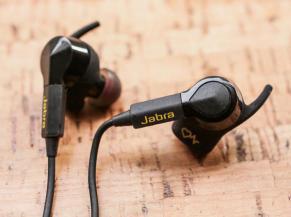

Given the integration of wireless headphones with the phone, get a compact and convenient strap and high-quality headphones for running, with no extra wires, and other devices for measuring heart rate.
For those who like to run with music, this decision will be the most original and comfortable.
An additional feature of the device is the ability to simultaneously connect it to multiple devices - for example to your phone or player, to play music, and a smart watch or cross-device to transmit readings of the pulse.
Mio Alpha 2 - this project from Kickstarter, has made it possible that the recently It did not seem very near future - using the compact optical sensor to measure heart rate right at hand. Well suited for someone who wants to watch their heart rate the whole day, not just during certain periods of training, besides the new model looks modern and beautiful, and it can be used as Smart watch, with the additional feature that fail to play smart watch from the industry giants.
We hope the information will be helpful and will make the right choice.
UPDATE: Most Commented direct users, have been clarified the wording of the text, and found that the data transfer protocol used by Polar, not the ANT / ANT +, and only the most recent models of the sensors supported by BT. Other sensors use Polar own transmission protocols, though using the same frequency band.
Source: geektimes.ru/company/icover/blog/252054/

We will try to describe the main technical features that define the functionality of the heart rate monitor to an untrained user is not overpaid for a device with redundant functionality, or hoping a simple device to solve the problem that it can not afford.
So, in spite of the wide variety of manufacturers and models, virtually all devices for measuring heart rate can be divided by a pair of main features:
- Pulse technology used;
- The protocol to use wireless data transmission;
The determining factor in terms of precision, quality, convenience Pulse - of course used for this technology.
In fact, the only review of technologies for measuring heart rate in runet, found only on geektimes ( time and два ), which is not surprising, but becomes the rule. Not all of the possible techniques may be used for the described mobile contact, so consider only two:
Electrocardiography - registration changes of electric fields that arise in the heart, to identify potential differences is necessary to measure at least two points of the body, possibly far apart


The figures are two types of such devices, despite differences in appearance, measurement technology, and accordingly accuracy - close.
Plethysmography - the measurement of the pulse based on the registration of the change of volume in the body, filled with blood (as a rule - in the blood vessels). Measuring occurring with a pulse wave by using mechanical, optical or impedance (electrode) methods. Mobile gadgets used almost exclusively optical plethysmography - photoplethysmography.

The table below briefly summarizes the main characteristics for each of the pulse measurement technology:
Option th> Electro-cardio (measurement at two points) th> Photo-plethysmography th> Benefits High accuracy Ease of use Weaknesses The disadvantage of the use / need to replace the belt with pins ( It depends on the manufacturer and usage in a month ... year) Low accuracy / dependence of measurement accuracy, the quality of the sensor, the weather (direct sunlight knock readings), the moisture content tr > Scope Sport Professional / Amateur Sports Amateur Sport / Sport «for fun» / Constant control pulse
To the reported heart rate is not remained in the pulse sensor and can be displayed in real time to the user, it is necessary to provide wireless transmission of data from the sensor to the display device or devices from the combined clock sensor + / fitness tracker - a computer for further analysis.
Now, virtually all modern sensors use one of the two, or both data transmission technology:
Bluetooth / Bluetooth 4.0 BLE - protocol wireless data transmission is used in a large number of devices to transfer data between devices, or sync them with your computer.
Ant / Ant + - a specialized protocol for wireless data transmission developed specifically for the exchange of data between devices designed for sports / health.
The following table lists the main differences between each technology
Data transfer protocol th> Bluetooth 4.0 (BLE) th> ANT / ANT + th> Benefits < / Widespread / protocol Open Low power / support complex topologies Connection Weaknesses High power consumption < / Indoor protocol (Dynastream-Garmin) Scope The integration of sensor pulse from independent producers, with more smartphones / hour etc. The integration of specialized sensors with running appliances (Polar / Garmin / Suunto, etc.) and some smart phones (the latest model Sony / Samsung, and others.)
Now, the possibility of introducing each technology in terms of heart rate measurement, and data will only determine that it is implemented in the device that you liked the design, or by the presence of some additional features.
Because all of the devices list is too long and inevitable repetition of nearly identical devices from different manufacturers, the final table lists only some of the most typical and original device models:
Device th> Runtastic Heart
Rate Monitor th> Garmin Heart
Rate Monitor th> Jabra Sport
Pulse th> Mio Alpha 2 th> Appearance




Device Description Runtastic Garmin HRM Jabra Sport Pulse Mio Alpha 2 Technology Pulse Electro-cardio Electro-cardio Camera plethysmography Photo-plethysmography Technology Data td> Bluetooth 4.0 Ant + < Bluetooth 4.0 Bluetooth 4.0 Additional
function - Integration with running devices GARMIN Forerunner Complete headphones + headset Waterproof < Scope Amateur Sports / Storing workout history with applications in the phone (Runtastic, Endomodo etc.) Professional /
Amateur sports / Saving graphs track the pulse and cloud Garmin, or via telephony applications Amateur Sport / Sport «for fun» / Saving rate and the track in your phone Amateur sport / Constant monitoring of heart rate Hours sensor 1-2 years 2-3 years Before 5:00 20 ... 24 hours The order value of the sensor in Russia 90..110 USD 130..150 USD 210..230 USD 200..220 USD Looking at the table, it is easy to make a choice, based on the purpose for which the acquired heart rate monitor.
If you want to basically understand what is the pulse as it changes throughout the day, or during sports activities, learn to manage stress in accordance with its pulse - you can try the easiest type of strap Runtastic, that will give you answers to these questions, and allow start accumulating the history of your activities.
If you know that you will eventually use the heart rate readings more often, and in the near future will be taken to the use of special cross-country equipment, demonstrates the workout statistics (not just pulse and pace / speed / time / distance, etc.) On the screen hours, your choice for the first step: strap from one of the leaders of the Garmin / Polar / Suunto.
Initially, it can be used with one of the cross-country applications for smartphones, and when necessary - to purchase a full-fledged instrument for monitoring the training process, for example, Garmin 910XT / Polar RCX5 / Suunto Ambit 3
We should also consider unique at the moment headphones, Jabra Sport Pulse .
Thanks to the development of quality sensors based on technologies fotopletizmograficheskoy Pulse, an opportunity to integrate the optical sensor in the earpiece, and to measure heart rate right inside the ear.


Given the integration of wireless headphones with the phone, get a compact and convenient strap and high-quality headphones for running, with no extra wires, and other devices for measuring heart rate.
For those who like to run with music, this decision will be the most original and comfortable.
An additional feature of the device is the ability to simultaneously connect it to multiple devices - for example to your phone or player, to play music, and a smart watch or cross-device to transmit readings of the pulse.
Mio Alpha 2 - this project from Kickstarter, has made it possible that the recently It did not seem very near future - using the compact optical sensor to measure heart rate right at hand. Well suited for someone who wants to watch their heart rate the whole day, not just during certain periods of training, besides the new model looks modern and beautiful, and it can be used as Smart watch, with the additional feature that fail to play smart watch from the industry giants.
We hope the information will be helpful and will make the right choice.
UPDATE: Most Commented direct users, have been clarified the wording of the text, and found that the data transfer protocol used by Polar, not the ANT / ANT +, and only the most recent models of the sensors supported by BT. Other sensors use Polar own transmission protocols, though using the same frequency band.
Source: geektimes.ru/company/icover/blog/252054/
Tags
See also
CES 2017: new year with new gadgets. Innovations and expectations
Ethereum: cryptocurrency next generation and decentralized application platform
Scales are getting smarter: a few options floor kitchen and smart-weights
25 best inventions of 2014.
Michael Khas'minskii: Families split about selfishness
Acid-base balance: the basic chemical processes in the body
Honey from the deck. Practice

















